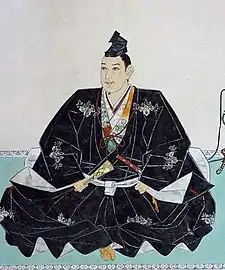Ukita Hideie
Ukita Hideie (宇喜多 秀家, 1573 – December 17, 1655) was the daimyō of Bizen and Mimasaka Provinces (modern Okayama Prefecture), and one of the council of Five Elders appointed by Toyotomi Hideyoshi.[1] Son of Ukita Naoie, he married Gōhime, a daughter of Maeda Toshiie. Having fought against Tokugawa Ieyasu in the Battle of Sekigahara he was exiled to the island prison of Hachijō-jima, where he died.
Ukita Hideie 宇喜多 秀家 | |
|---|---|
 | |
| Ukita family head | |
| In office 1582–1600 | |
| Preceded by | Ukita Naoie |
| Succeeded by | Ukita Hidetaka |
| Personal details | |
| Born | 1573 Bizen Province, Japan |
| Died | December 17, 1655 Hachijōjima, Japan |
| Nationality | Japanese |
| Spouse(s) | Gōhime |
| Father | Ukita Naoie Toyotomi Hideyoshi (adopted father) |
| Relatives | Maeda Toshiie (father-in-law) Toyotomi Hideyoshi (father-in-law) |
| Military service | |
| Allegiance | |
| Unit | |
| Battles/wars | Shikoku Campaign Odawara Campaign Korean Campaign Battle of Sekigahara |
Rise to prominence
Hideie's father Naoie was daimyō of Bizen province and initially opposed, but later sided with Oda Nobunaga and Toyotomi Hideyoshi. Naoie died in 1581, and in 1582 Hideie became the head of the Ukita clan. As Hideie was still young, it was Hideie's uncle (Ukita Tadaie) who acted as leader of the Ukita army (under Toyotomi Hideyoshi) during the siege of Bitchū Takamatsu Castle in 1582. Nobunaga was assassinated on June 2 of that year, but the siege continued until the castle fell two days later. Hideyoshi raced back to Kyoto, leaving the Ukita clan in charge of Bizen, Mimasaka and newly taken parts of Bitchū Provinces. The Ukita were also to keep watch on Mōri Terumoto to the west.
He participated in the Invasion of Shikoku (1585).[2] In 1586, Hideie was married to Hideyoshi's adopted daughter, Gōhime. (She had been adopted by Hideyoshi from Maeda Toshiie.)
Hideie joined Hideyoshi's military campaigns in the Siege of Odawara (1590). Following the unification of Japan under Hideyoshi, Hideie served as a chief commander in the Second Korean campaigns, returning in 1598 to serve as one of Hideyoshi's five counselors, along with Maeda Toshiie, Uesugi Kagekatsu, Mōri Terumoto, and Tokugawa Ieyasu.
_Banner.jpg.webp)
Battle of Sekigahara
Hideyoshi died in 1598, leaving his five-year-old son Hideyori as his successor and Tokugawa Ieyasu moved to take control. As he was very close to Hideyoshi, Ukita naturally sided with the Toyotomi loyalists under Ishida Mitsunari (the Western army). He took 17,000 men to fight in the Battle of Sekigahara. His army fought against Fukushima Masanori in what is said to have been one of the bloodiest confrontations in the battle. Ukita's troops were winning the battle, pushing back Masanori's army however, being unaware that his allies stationed nearby had made a secret deal with the enemy, his momentum was halted when his allies attacked and together with turncoats, Masanori's army took control of and won the battle. One of the defectors, Kobayakawa Hideaki, was granted Okayama Castle and surrounding Ukita territories by the Tokugawa as a reward for his betrayal, which is believed to have been the decisive factor in the Tokugawa victory.
Hideie was angered by the betrayal and initially intended to hunt down Kobayakawa for a man-to-man duel but was stopped by his advisors. After escaping the battle, he went into hiding in Satsuma Province where his former allies protected him for several years. In 1603 however, Shimazu Tadatsune informed the Tokugawa shogunate of Hideie's location, and he was forced to appear before Tokugawa himself where he was sentenced to exile on the island of Hachijō-jima, along with several supporters, including his two sons. Hideie's wife sought refuge with the Maeda clan and was able to correspond and send gifts (rice, sake, clothing) to her husband and sons from there.
Hideie eventually outlived his wife and all of the Sengoku Jidai era samurai except Sanada Nobuyuki. He was offered a conditional pardon after Ieyasu's death, but declined and never returned to the mainland. His wife had died, the Toyotomi were defeated, there was no place to return to, his sons had fathered children on Hachijojima, and the Shogunate was to be inherited by members of the Tokugawa clan.
There is no evidence to suggest that Hideie fathered any further children himself, but many of his sons' descendants emigrated back to the Japanese mainland when a full pardon was granted at the end of the Edo era.
Notes
- Kodansha. (1983). "Ukita Hideie", in Kodansha Encyclopedia of Japan, Vol. 8, pp. 137–138.
- Turnbull, Stephen (1998). The Samurai Sourcebook. London: Cassell & Co. p. 236. ISBN 9781854095237.
References
- Kodansha. (1983). "Ukita Hideie," in Kodansha Encyclopedia of Japan. Tokyo: Kodansha. OCLC 233144013
External links
| Wikimedia Commons has media related to Ukita Hideie. |
- Okayama City's page on Hideie (in Japanese)
| Preceded by Ukita Naoie |
Ukita family head 1582–1600 |
Succeeded by Ukita Hidetaka |
